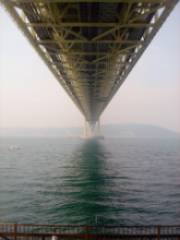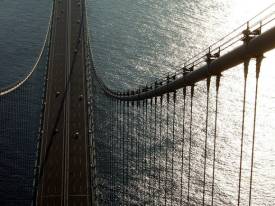The first bridges used by humans weren’t even man-made – they were as simple as a log falling over the river in a certain way, or a bunch of rocks that allowed safe crossing of a river.
Bridges have always been a human necessity, and prove a unique challenge to whoever is building them. No two bridges will sit on the exact same space of land, and as such each bridge design is completely unique and built to meet its own set of engineering challenges.
Humanity has come a long way since those first logs and rocks, just take a look at the world’s longest suspension bridge, completed in Japan in 1998. The Akashi Kaikyo suspension bridge spans 1,991 meters (or 6,532 feet), beating the second longest suspension bridge – the Xihomen Bridge in China by a clear 300 meters (span 1,650 meters or 5,414 feet).
How did this incredible feat of engineering come about? What went into its unique design, and how did the Japanese construct it? All these questions and more, answered below.
A construction necessitated by tragedy

Akashi Bridge
The Akashi Kaikyo Bridge spans the treacherous Akashi Straits and links the outer isle of Awaji to the mainland city of Kobe. Before the bridge, numerous ferries would take passengers between the islands - a dangerous task due to the traffic crossing both way throughout the strait.
In 1955 tragedy struck when during poor weather, two ferries - the Shin Maru and Uko Maru - collided. The Shin Maru was carrying 100 students from elementary and junior high school on a school field trip. The resulting collision and sinking of the ferries led to the deaths of everyone on board. This tragedy and the following public outcry forced the Japanese government to begin planning a bridge that would alleviate some of the water traffic in the Akashi Straits.
Planning starts, problems faced
Besides the initial span that had to be covered, the bridge supports also had to be able to comfortably sit at a depth of 100 meters (328 feet), with the water currents averaging 14 kmph (9 mph). Sitting well within a typhoon region, the bridge had to be able to withstand winds of up to 290 kmph (180 mph), as well as earthquakes and tsunamis. Furthermore, the bridge had to allow for a 1,500 meter (4,921 foot) shipping lane due to the Akashi Strait being an international waterway.
In 1988, construction began on the Akashi Kaikyo Bridge, which pushed architectural design to the limit with its unprecedented length.
Finding the best design
The principal design of a suspension bridge (especially for the longest suspension bridge in the world) necessitates a platform suspended between two cables. Before any construction began in earnest, the Japanese engineers created large scale models with one of them measuring as long as 40 meters (131 feet) to put through rigorous testing.
One of the models was put into a wind tunnel in order to simulate the potential storm force wind speeds. The attention to detail that went into each of these models, and the conditions they were put under allowed the builders and designers to greatly refine their design. Initially, they planned for dual railway/roadway bridge but thanks to the rigorous testing, the idea was scrapped and a 6-lane roadway was judged to be the best way going forward.
The construction begins

One of Akashi Bridge's 929 feet high support towers (Photo credit: Wikipedia)
The first part of construction was building the towers and placing them out at sea. Here the Japanese faced their first problem as they discovered regular concrete would erode too quickly under such large exposure to salt water. Therefore the engineers had to create a new mix of concrete, one that used sea water in the mixture, which provided greater defense against the salt erosion.
Next were the anchoring towers sitting at each end of the bridge which needed to weigh a very large amount, a crushing 350 000 tons in fact. After crafting the towers with the anchoring blocks and the foundations laid, they began building the two towers, each one standing 283 meters (929 feet) in height, nearly as high as the Eiffel Tower in Paris. Each tower was constructed with startling precision, with the design allowing for only a 22mm offset at the very top
- anything more may have led to unforeseen flaws in the final construction.
A bridge takes shape

The bridge deck from below (Photo credit: Aurelio Asiain)
With the all the foundations laid, all that remained was for the workers to suspended the cables and the roadway.
To facilitate construction, a temporary scaffold was constructed that allowed workers to move about freely and hang the the thousands of miles of steel cables that would support the entire structure. While workers affixed the cables, massive cranes custom built for this work hoisted the 4000 ton pieces of the deck into place.
The bridge deck is comprised of 290 of these sections, featuring triangular sections underneath the roadway which maximized the strength of each section while minimizing the overall weight of them.
Finally the final piece was laid in August 1998, ten years after the bridge began its construction.
The Akashi Kaikyo Bridge is completed
The bridge was opened to traffic in April of 1998. The approximate cost was 500 billion yen ($3.6 billion USD), which the builders hoped to recoup with a toll of 2,300 yen. Despite an annual revenue of about 20 billion yen, it’s widely believed that, with interest rates accounted for - the builders will never pay back the entire cost of the project.

A view of the akashi bridge from the top of a support tower (Photo credit: hiroaki)
Two million workers had a hand in the construction of the bridge, and it still took them 10 year to complete the project.
Each cable holding the deck of the bridge has 300,000 km (190,000 miles) of steel wire, each cable is comprised of smaller cables 112 centimeters of diameter and each of the larger cables is comprised of 36,830 strands.
In a land like Japan with great monuments like the Himeji Castle, technological marvels like the Shinkansen, and the natural beauty of Mount Fuji,it is a country which seems to have it all. And what country holds the longest suspension bridge in the world? Japan of course. The Akashi Kaikyo Bridge is a modern technological marvel and is a great display of the scope of human ingenuity.